Back in 2015, Stuart Bullen discussed BlueBolt’s visual effects work on The Man from U.N.C.L.E.. Since then, his credits have included Spectre, Now You See Me 2, Catherine the Great, and Belgravia. In 2020, he joined RISE, where he contributed to The Wheel of Time, Ms. Marvel, Guardians of the Galaxy Vol. 3, and The Marvels.
How did you and RISE get involved on this show?
We’ve built a great working relationship with Marvel and, more specifically, with Freddy, the show’s producer, as we worked with him on an earlier Marvel project.
How was the collaboration with the showrunner and VFX Supervisor Gong Myung Lee?
Simply put, wonderful. I love working with people that are talented and enjoy what they do, there’s an energy and passion they bring which I love and we carry that through into our work.
What are the sequences made by RISE?
We are proud to be the sole vendor handling the iconic Daredevil oner in episode 1 along with its surrounding shots in the fight sequence involving Daredevil and Bullseye.
Can you take us through the process of designing the intricate oner sequence between Daredevil and Bullseye? How did RISE approach such a challenging shot in terms of both choreography and visual effects?
The complexity here is that the oner had a running time of around 7000 frames, which when you compare to an average VFX shot being 250 frames the complexity begins with its length, and dealing with a sequence like this can easily become a runaway train if you don’t plan well.
I generally like to simplify shots into it’s most basic of elements. I began with creating a flow chart covering each shot and it’s core requirements, for example what assets needed: digi doubles, set extensions, props, cleanup, FX. An additional tier to this would be how to achieve the stitch to the next shot.
From there you go into further detail. Continuity has to be something to be constantly aware of on a sequence like this. Not just with ensuring your VFX work matches from shot to shot like the daggers impaled in Daredevil, but also the live action elements that may have moved between shots for example bottles on the bar, barstools and even extras standing in different spots.
First and foremost the challenge was to make 19 individual shots stitch seamlessly, and the brief here was to not use the typical cheats for stitching which is to have characters pass camera allowing a classic wipe action to take place, instead we were required to bridge the gap by transitioning from live action characters to digi doubles and back again. As each individual shot wasn’t always filmed with the same lens or camera position we needed to not only introduce digi characters but also environments had to be fully taken over. The cameras then needed to be animated from shot position A to shot position B within our stitch move.
A nod needs to be given to Florian Coquaz, FX Lead, and the FX team for the smoke work in the bar. This was a key component in aiding the stitching. The smoke not only needs to run from the start of the bar fight to the end, some 3000 frames, it also needs to gently move around the room, interact with the action (which means all live action needs to be rotomated to get accurate smoke displacement), it also became a way to frame the fight. We crafted it to dissipate in moments where we wanted to draw the audiences attention towards something or sometimes to hide areas of a frame. Wrangling the renders for such large simulations wasn’t easy, especially when you factor in multiple versions to hit all creative notes.
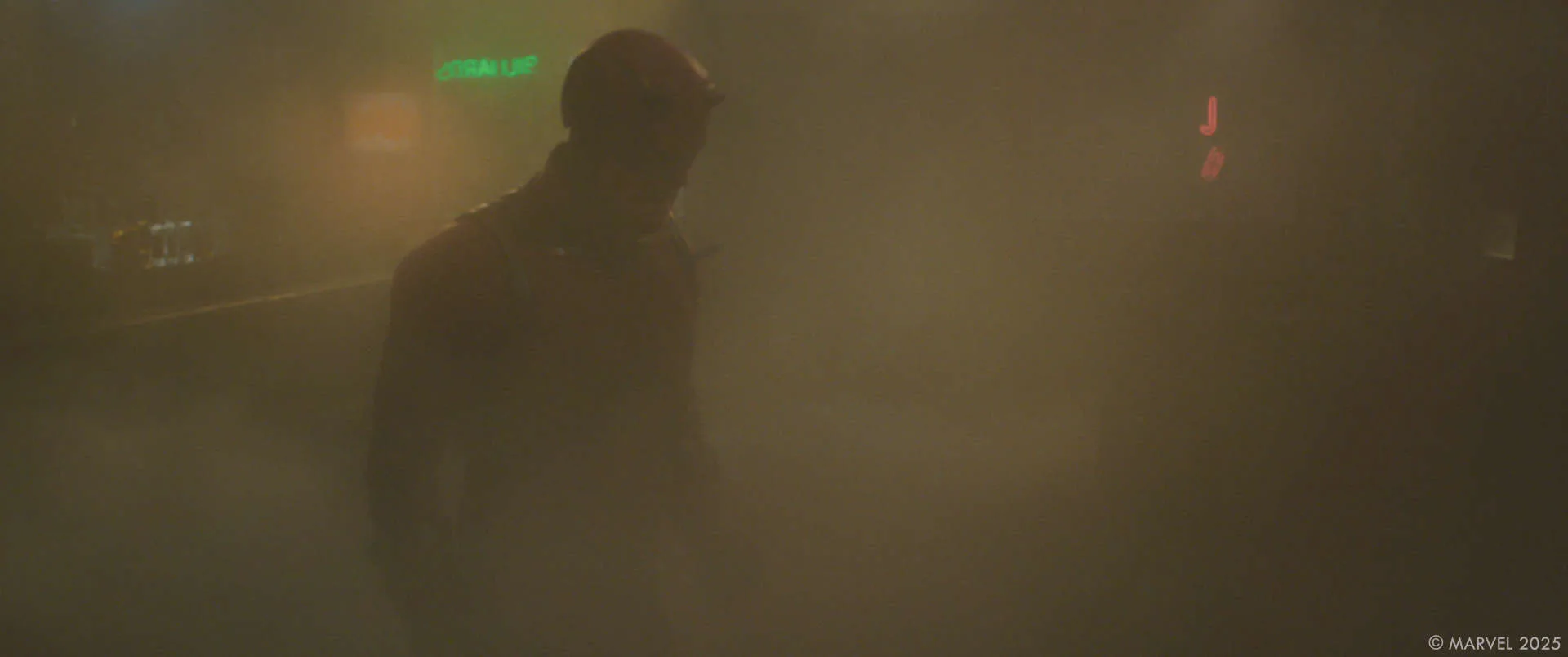
One of the most impressive aspects of the scene is the seamless transition between practical and digital elements. Can you explain how you achieved these invisible transitions, especially during the high-intensity moments of the fight?
This comes down to impeccable work by the CG Supervisor Alex Twigg and his team. Asset work on the digi doubles (we were the main vendor creating the Daredevil and Bullseye digis) and the bar environment began as soon as we were awarded the work and the scenes were shot.
The key components to making seamless transitions beyond having perfect matches for characters and environments is a talented tracking team. Our tracking team headed up by Matt Boyer made what was a challenging assignment look very easy. Environments and the characters movements needed tracking to allow a hand over to the animation team.
Another nod needs to be given to our talented lighters like Kat Goslowsky, who’s eye for matching on-set lighting in to our digital world meant there was no way to spot the take over into our digital assets.
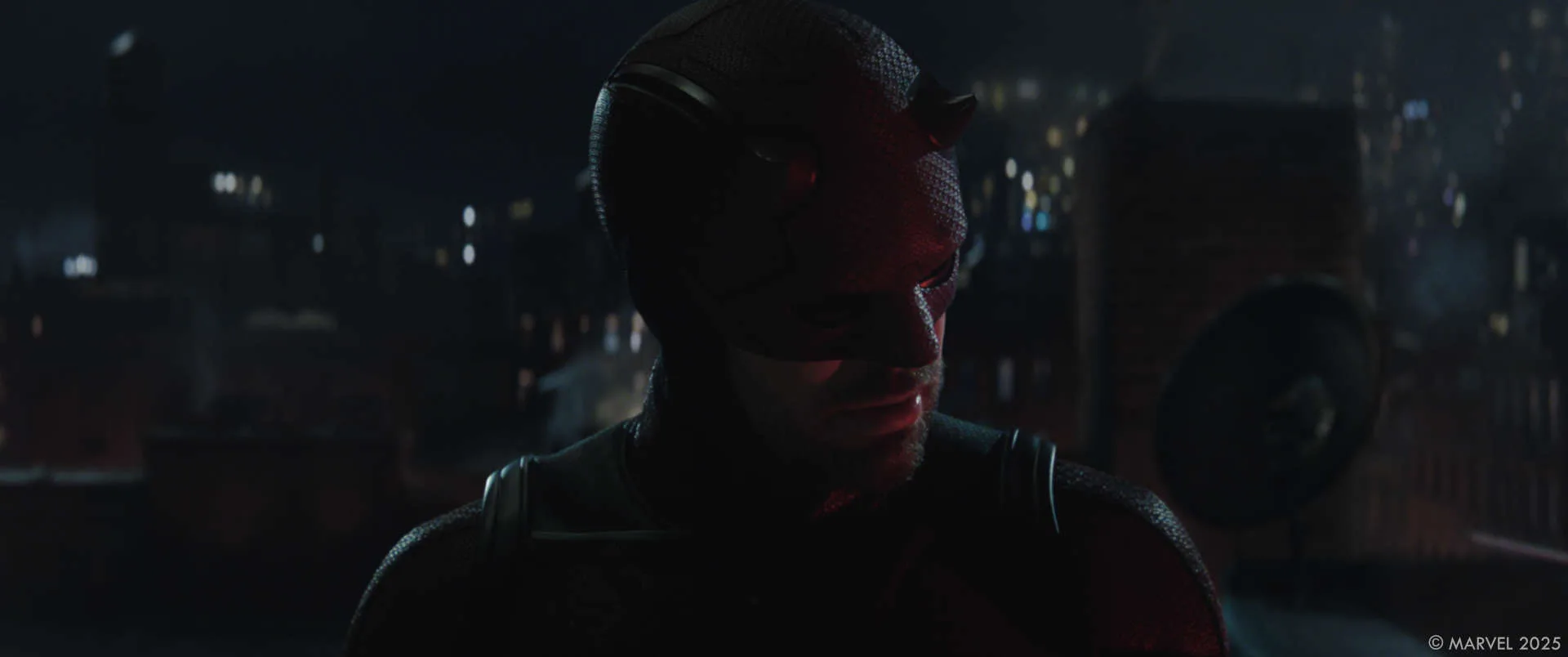
In this oner, the camera follows the characters fluidly, even through tight spaces. What were the biggest challenges in blending the VFX with the practical camera work, and how did you ensure a smooth, unbroken flow throughout the sequence?
Two key elements come to mind, tracking and animation. Without a tight track nothing will feel right, and if the animation in the characters is off at all then the audience will know straight away.
Weapons, such as Bullseye’s throwing knives, play a crucial role in the sequence. How did RISE approach the creation and integration of these digital weapons while maintaining the tension and pacing of the fight?
On set there weren’t any knives handled, nor thrown for obvious reasons. We made 4 knife assets. As we know, Bullseye is known for hitting his mark no matter how he throws the knives. We needed to be creative in the trajectory of the throws for them to not always be a direct path with most of the time having them ricochet off surfaces first. They then needed to be tracked in to place where ever they landed, which most of the time was on Daredevil’s torso. A point worth mentioning about his torso. On set tracking markers were stuck to Charlie’s suit in order for us to track the daggers on to him, we found that replacing his whole torso with a CG asset proved a more cost effective route than to paint out the markers and then add on just the daggers.
Additional CG weapons used in the fight were Daredevil’s Billyclub, gun, glass bottles, a pool ball and a can of spinach. For all of these items we needed solid tracking of not just the camera and therefore the environment, but also rotomation of the characters. There were scenes where many knives were thrown in quick succession and our animation team did a fantastic job wrangling it all.
A few of us acted out the fight sequences for the animators to reference, we found that to be the best method in adding realism and physicality to our animation, which is something we also did in our previous Marvel show, Guardians of the Galaxy Vol. 3 where we acted out Groot scenes.
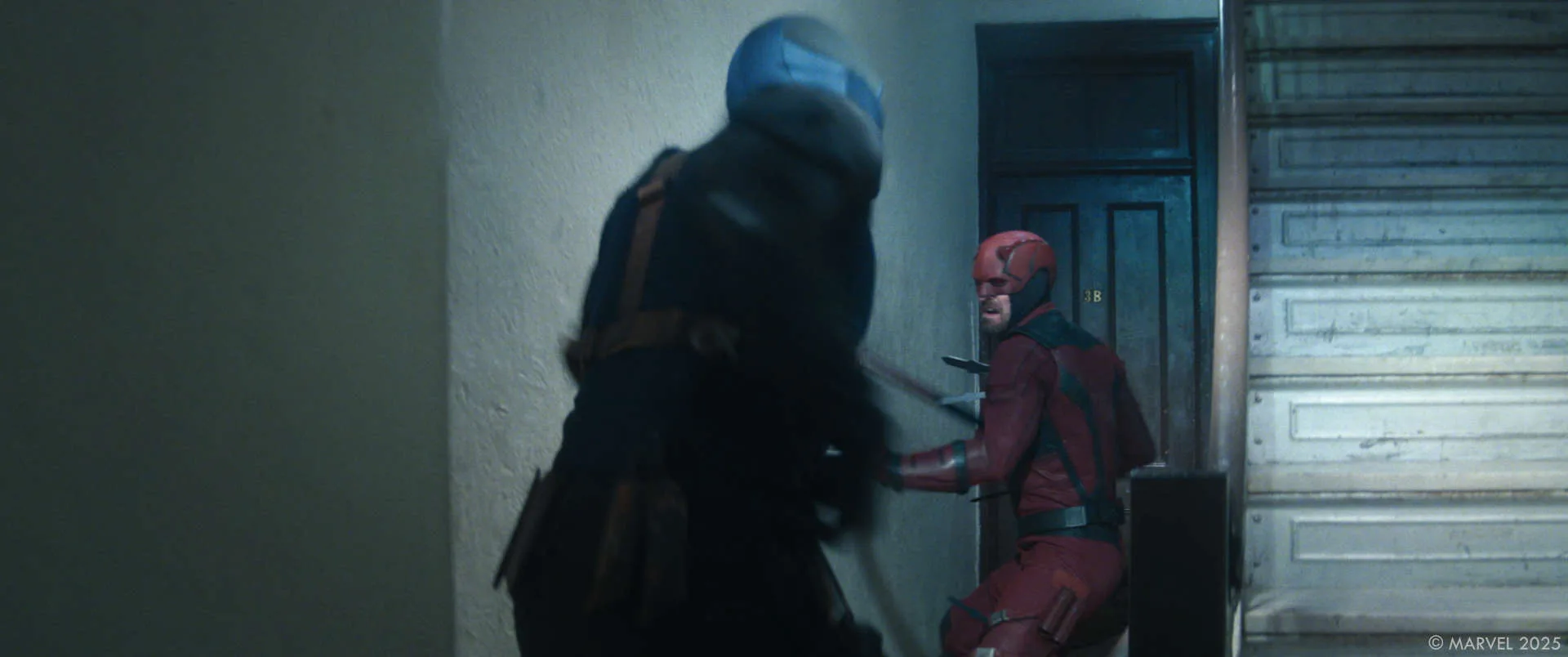
One of the most memorable shots is the slow-motion close-up of Daredevil’s mask. What was the thought process behind this shot, and how did you approach the digital breakdown of the mask in such a stylized moment?
Being a fan of the show since it first aired I was excited to have this shot, the hanging up of the cape if you will. We had a backplate to work with where we look down to street level, and so we used our digital helmet asset and began to add additional modelling and texturing for this hero moment. The helmet had to reflect all the action that had just taken place, from ensuring the horn was sliced off with the metal being chipped and scrapped (notice the area where the horn once was, is in the shape of a ‘D’), to adding blood splatter from all those blows he threw Bullseyes way.
I love adding details to shots even if only one or two people ever catch them. For example when Bullseye hit the ground we added a pool of blood that spread out from his body, later we see that he survives, and by the time we get to this shot he’s left the scene.. In this shot we see the spot where he landed and so we added that pool of blood there too, however the filmed footage also has an ambulance driving over that spot where the blood is, and so we added the detail that the ambulance leaves bloody tire tracks behind as it drives over the blood.
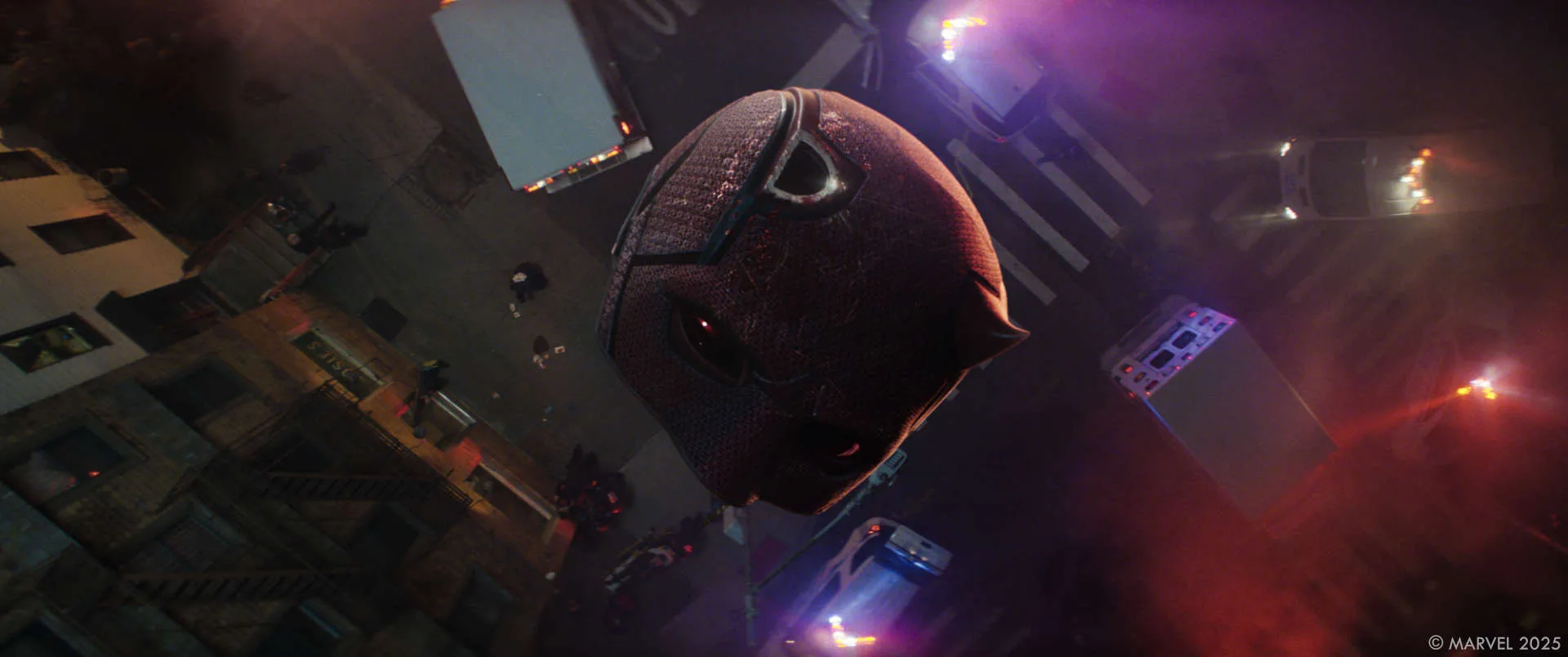
New York, particularly Hell’s Kitchen, plays a huge role in Daredevil: Born Again. Can you tell us about the process of creating the environments digitally, and how you made sure they reflected the gritty, lived-in feel of the neighborhood?
We kept true to where Hell’s kitchen is located and so whenever we were on a rooftop we ensured we included the correct skyline. Gong Myung Lee and her team shot environment back plates for us which was our base to work from. From there we added additional layers of DMP and CG buildings. The buildings closest to camera were cg to allow us full lighting control not just so we could match the lighting on set but to also add lights from emergency vehicles as they travelled down the streets towards us.
A little side note on the buildings, its all well and good designing buildings but if you don’t populate the interiors of them then you’re job’s half done, and so we shot our RISE team on greenscreen acting out difference poses that we then populated around the city, and that includes our office dog Tango.
The buildings needed to look weathered, worn and broken with cracked and chipped stone work and graffiti scattered about the place.
To add the grittiness we shrouded NYC in low level mist / fog to diffuse the light, it not only looks cool but serves the purpose of not attracting too much attention on screen and away from the action.
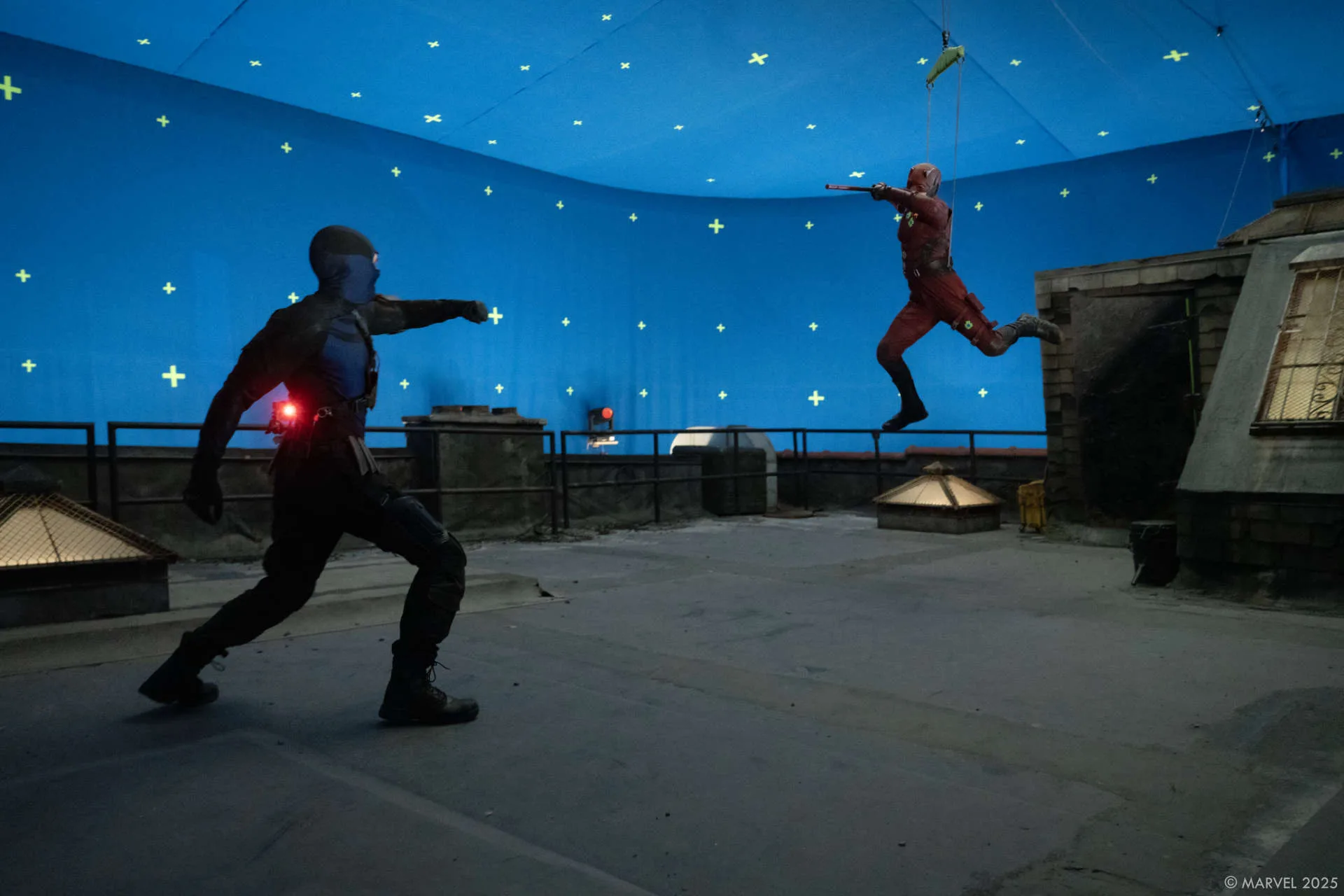
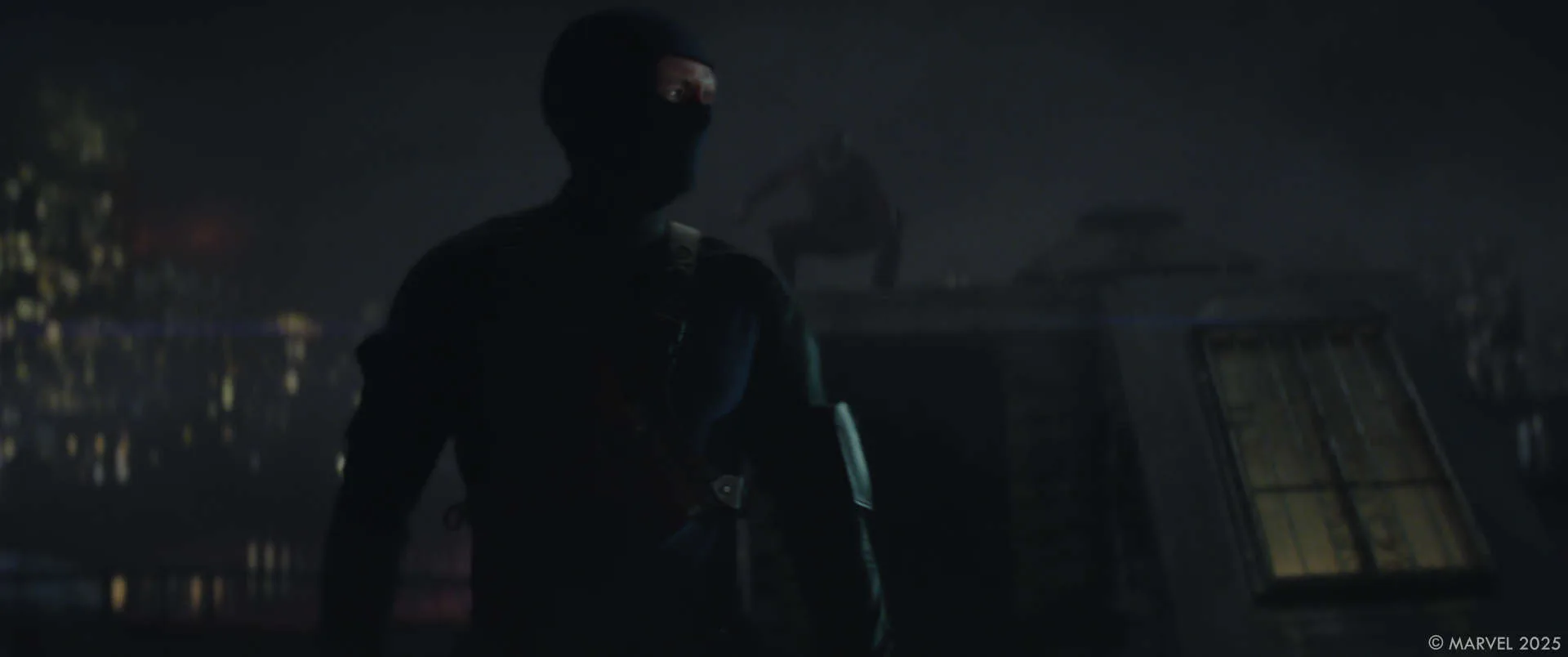
How did RISE collaborate with the production design team to capture the essence of Hell’s Kitchen, and how much of the environment was created digitally versus filmed on location?
RISE took on recreating the interiors of the bar, stairwell and rooftop, and for these we had Lidar scans of the sets, its worth noting that these 3 locations are not all in one place. The bar is a real location, the stairwell and rooftop was on a sound stage and not connected to one another, so we needed to connect these 3 pieces together requiring additional environment modelling.
When we are on the rooftop all surrounding buildings are digital assets. When Daredevil and Bullseye are on the edge of the roof the camera tilts down to ground level we do an environmental take over there. The rooftop was filmed about 1 story up and so we created the exterior facade of Josies bar to give the impression of us being 5-6 stories high.
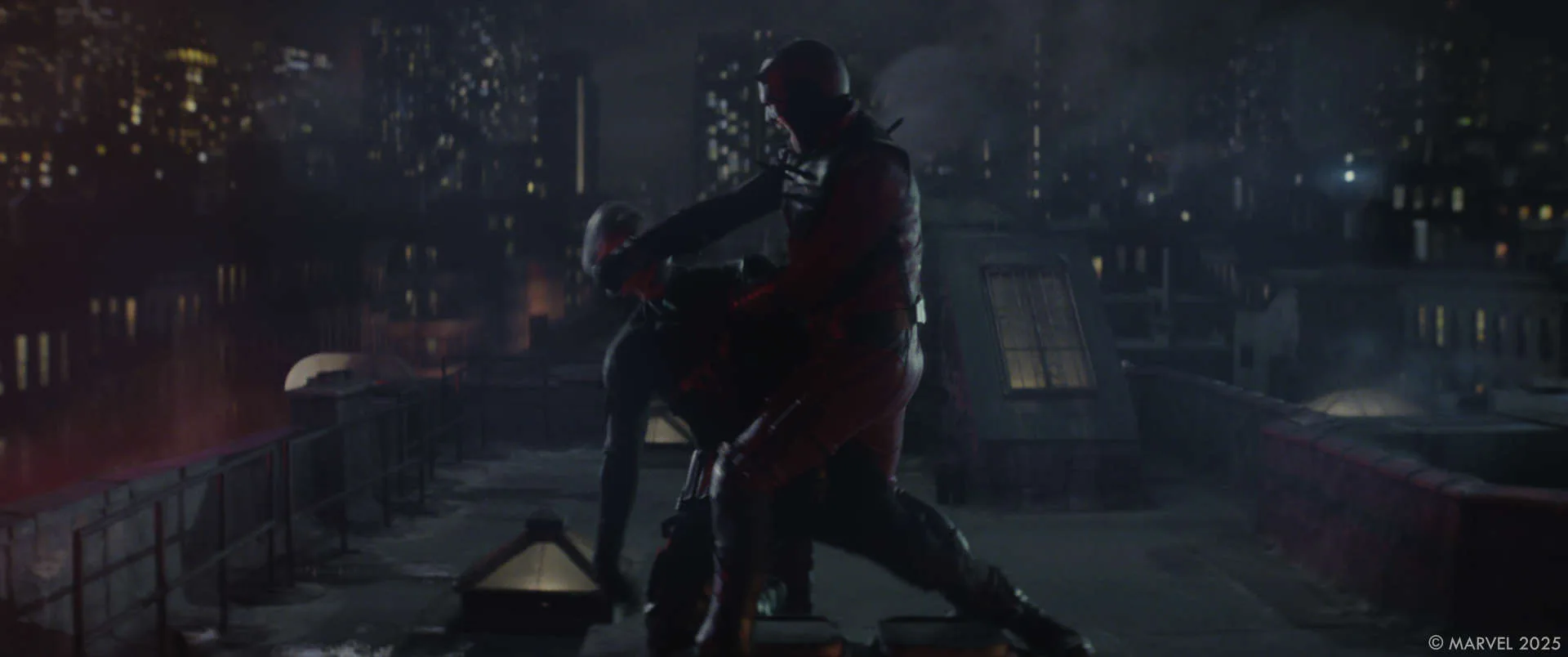
Looking back on the project, what aspects of the visual effects are you most proud of?
Looking back at the transitions from the live action characters and environments to the complete digi take over of both and not being able to tell where the stitch happens is amazing. I’m proud of every artist and production member on this show. It wasn’t just a creative challenge, the scheduling of the team was no small feat and deserves a call out.
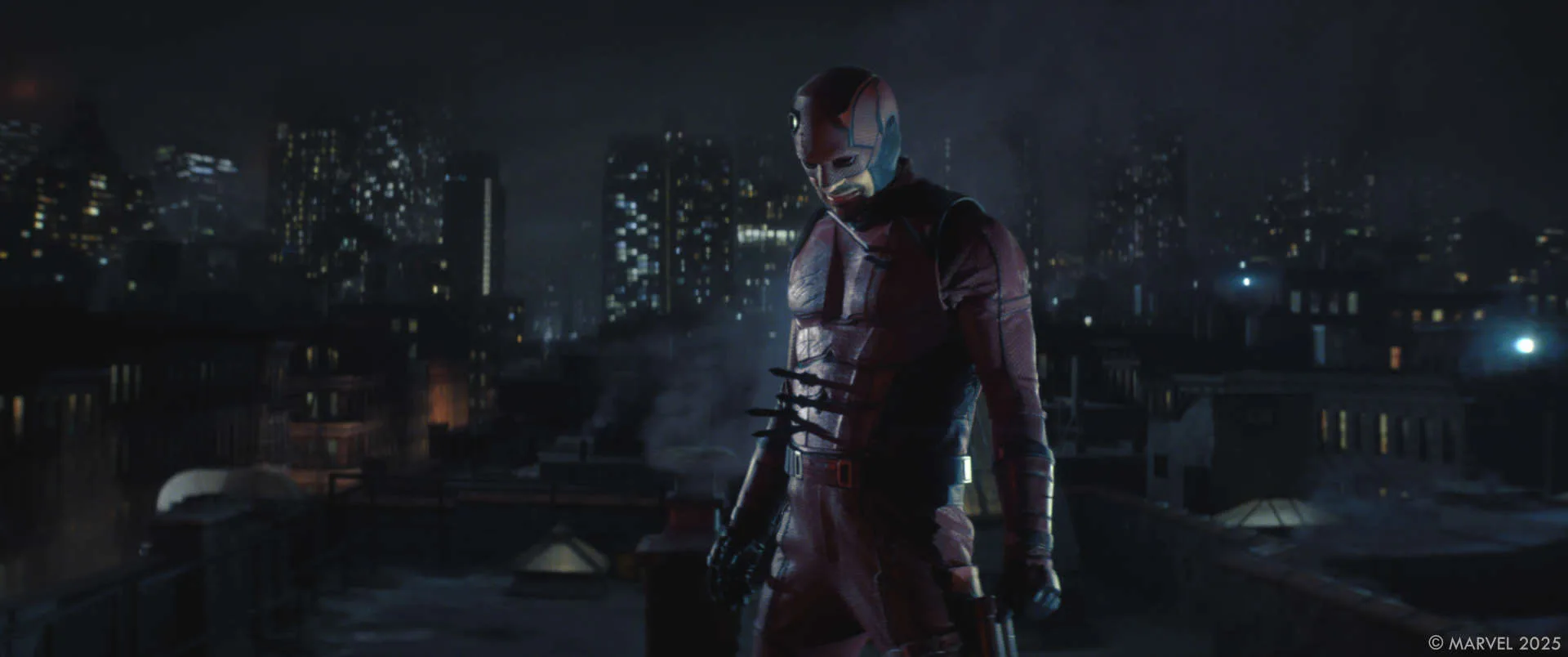
How long have you worked on this show?
We started March 24 and delivered towards the end of December that year, almost 9 months.
What’s the VFX shots count?
105.
What is your next project?
As always we have a few we cant mention at the moment, however one we can is the final installment of Mission Impossible – The Final Reckoning.
A big thanks for your time.
WANT TO KNOW MORE?
RISE: Dedicated page about Daredevil: Born Again on RISE website.
© Vincent Frei – The Art of VFX – 2025




